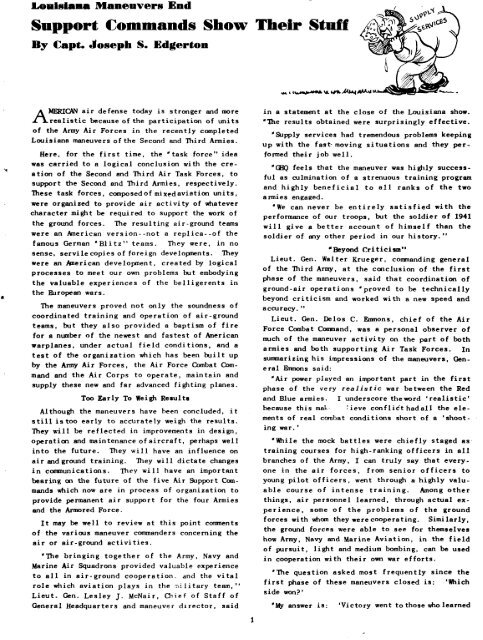News Letter 1941 Jul-Dec - Air Force Historical Studies Office
News Letter 1941 Jul-Dec - Air Force Historical Studies Office
News Letter 1941 Jul-Dec - Air Force Historical Studies Office
Create successful ePaper yourself
Turn your PDF publications into a flip-book with our unique Google optimized e-Paper software.
Loulsl ••• Maneuvers End<br />
Support Commands Show Their Stuff<br />
By Capt. Joseph S. Edgerton<br />
•<br />
AMERiCAN air defense today is stronger and more<br />
realistic because of the participation of uni ts<br />
of the Army <strong>Air</strong> <strong>Force</strong>s in the recently completed<br />
Louisiana maneuvers of the Second and Third Armies.<br />
Here, for the first time, the" task force" idea<br />
was carried to a logical conclusion with the creation<br />
of the Second and Third <strong>Air</strong> Task <strong>Force</strong>s, to<br />
support the Second and Third Armies, respectively.<br />
These task forces, composed of mixed aviation units,<br />
were organized to provide air activity of whatever<br />
character might be required to support the work of<br />
the ground forces. The resulting air-ground teams<br />
were an American version--not a replica--of the<br />
famous German "Blitz" teams. They were, in no<br />
sense, servile copies of foreign developnents. They<br />
were an American development, created by logical<br />
processes to meet our own problems but embodying<br />
the valuable experiences of the belligerents in<br />
the European wars.<br />
The maneuvers proved not only the soundness of<br />
coordinated training and operation of air-ground<br />
teams, but they also provided a baptism of fire<br />
for a number of the newest and fastest of American<br />
warplanes, under actual field conditions, and a<br />
test of the organization which has been built up<br />
by the Army <strong>Air</strong> <strong>Force</strong>s, the <strong>Air</strong> <strong>Force</strong> Combat Command<br />
and the <strong>Air</strong> Corps to operate, maintain and<br />
supply these new and far advanced fighting planes.<br />
Too Early To Weigh Results<br />
Although the maneuvers have been concluded, it<br />
still is too early to accurately weigh the results.<br />
They will be reflected in improvements in design,<br />
operation and maintenance of aircraft, perhaps well<br />
into the future. They will have an influence on<br />
air and ground training. They will dictate changes<br />
in comnunications. They will have an important<br />
bearing on the future of the five <strong>Air</strong> Support Commands<br />
which now are in process of organization to<br />
provide permanent air support for the four Armies<br />
and the Armored <strong>Force</strong>.<br />
It may be well to review at this point comments<br />
of the various maneuver commanders concerning the<br />
air or air-ground activities.<br />
"The bringing together of the Army, Navy and<br />
Marine <strong>Air</strong> Squadrons provided valuable experience<br />
to all in air-ground cooperation. and the vital<br />
role which aviation plays in the ~li 1itary team,"<br />
Lieut. Gen. Lesley J. McNair, Chief of Staff of<br />
General Headquarters and maneuver director, said<br />
in a statement at the close of the Louisiana show.<br />
"The results obtained were surprisingly effective.<br />
'Supply services had tremendous problems keeping<br />
up with the fast- moving situations and they performed<br />
their job well.<br />
"GHQ feels that the maneuver was highly successful<br />
as culmination of a strenuous training program<br />
and highly beneficial to all ranks of the two<br />
armies engaged,<br />
"We can never be entirely satisfied with the<br />
performance of our troops, but the soldier of <strong>1941</strong><br />
will give a better account of himself than the<br />
soldier of any other period in our history."<br />
-Beyond cri ticism"<br />
Lieut. Gen. Walter Krueger, commanding general<br />
of the Third Army, at the conclusion of the first<br />
phase of the maneuvers, said that coordination of<br />
ground-air operations "proved to be technically<br />
beyond criticism and worked with a new speed and<br />
accuracy. "<br />
Lieut. Gen. Delos C. Emmons, chief of the <strong>Air</strong><br />
<strong>Force</strong> Combat Comnand, was a personal observer of<br />
much of the maneuver activity on the part of both<br />
armies and both supporting <strong>Air</strong> Task <strong>Force</strong>s. In<br />
summarizing his impressions of the maneuvers, Gene<br />
ral Enmons said:<br />
"<strong>Air</strong> power played an important part in the first<br />
phase of the very realistic war between the Red<br />
and Blue armies. I underscore theword 'realistic'<br />
because this rnak.- :ieve conflict had all the elements<br />
of real combat conditions short of a 'shooting<br />
war.'<br />
"While the mock battles were chiefly staged as<br />
training courses for high-ranking officers in all<br />
branches of the Army, I can truly say that everyone<br />
in the air forces, from senior officers to<br />
young pilot officers, went through a highly valuable<br />
course of intense training. Among other<br />
things, air personnel learned, through actual experience,<br />
some of the problems of the ground<br />
forces with whom they were cooperating. Similarly,<br />
the ground forces were able to see for themselves<br />
how Army, Navy and Marine Aviation, in the field<br />
of pursuit, light and medium bombing, can be used<br />
in cooperation with their own war efforts.<br />
"The question asked most frequently since the<br />
first phase of these maneuvers closed is: 'Which<br />
side won?'<br />
'My answer is: 'Victory went to those who learned<br />
1
















